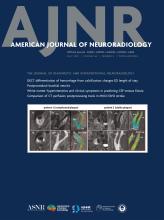AJNR Case Collection
Section Editors:
Anvita Pauranik, MD, University of British Columbia, Vancouver, British Columbia, Canada
Michael Travis Caton, MD, Mount Sinai South Nassau, New York
Simona Gaudino, MD, Università Cattolica del Sacro Cuore, Italy
Matthew S. Parsons, MD, Mallinckrodt Institute of Radiology, Missouri
Anat Yahav-Dovrat, MD, University of Toronto, Canada
Discussion:
Background: Dysgenetic polycystic disease (DPD) is among the rarest cystic conditions affecting the salivary glands. It is considered a developmental malformation where the normal parenchyma is replaced by multiple cystic spaces of varying sizes. The condition is more common in women and primarily affects young adults, with a mean age of 30 years, though cases have been documented in patients ranging from 6 to 83 years old. Lesions are most frequently found in the parotid glands, with fewer cases involving the submandibular and minor salivary glands.
Clinical Presentation: The classic clinical presentation of dysgenetic polycystic disease involves nontender swelling of the affected salivary glands, which can be constant or episodic, and occurs without signs of inflammation or abnormalities in salivation.
Key Diagnostic Imaging Features: The affected salivary glands exhibit multiple nonenhancing cystic spaces replacing the normal parenchyma. MRI of the head and neck offers valuable information for assessing the extent of the disease and excluding malignancy.
Differential diagnosis for diffuse minor salivary gland involvement includes multifocal cystic salivary gland tumors such as Warthin tumor, acinic cell carcinoma or sclerosing cystic adenoma.
Acinic cell carcinoma is usually a painless and slowly growing tumor that occurs mainly in the parotid gland with the rest arising mostly intraorally or in the submandibular gland.
Sclerosing polycystic adenoma is a rare benign tumor of the salivary glands, also usually involving the parotid glands. The tumor is usually multinodular, with 1–2-mm cysts. It might be multifocal. Differentiation between dysgenetic polycystic disease and sclerosing polycystic adenoma is difficult on imaging alone and is achieved by tissue sampling.
For diffuse involvement of the parotid glands, differential diagnosis additionally includes Sjögren syndrome, benign lymphoepithelial lesions of HIV, and sialoceles.
Management: Complete surgical excision is the acceptable treatment for DPD, as the lesions are benign, and excision is considered curative. In a diffuse disease, as seen here, complete excision is not a feasible option. Conservative management involves thorough oral hygiene to prevent secondary infections and the use of antimicrobial agents to address exacerbations.
References:
- Koudounarakis E, Willems S, Karakullukcu B. Dysgenetic polycystic disease of the minor and submandibular salivary glands. Head Neck 2016;38:E2437–39 doi:10.1002/hed.24401
- Srikant N, Yellapurkar S, Boaz K, et al. Dysgenetic polycystic disease of minor salivary gland: a rare case report and review of the literature. Case Rep Pathol 2017;2017:1–5 doi:10.1155/2017/5279025
- Bruett CT, Freedman PD, Reich RF. Dysgenetic polycystic disease of the salivary glands: a case report of this rare entity occurring for the first time in the minor salivary glands of the tongue, and a review of the literature. Head Neck Pathol 2024;18 doi:10.1007/s12105-023-01607-0











